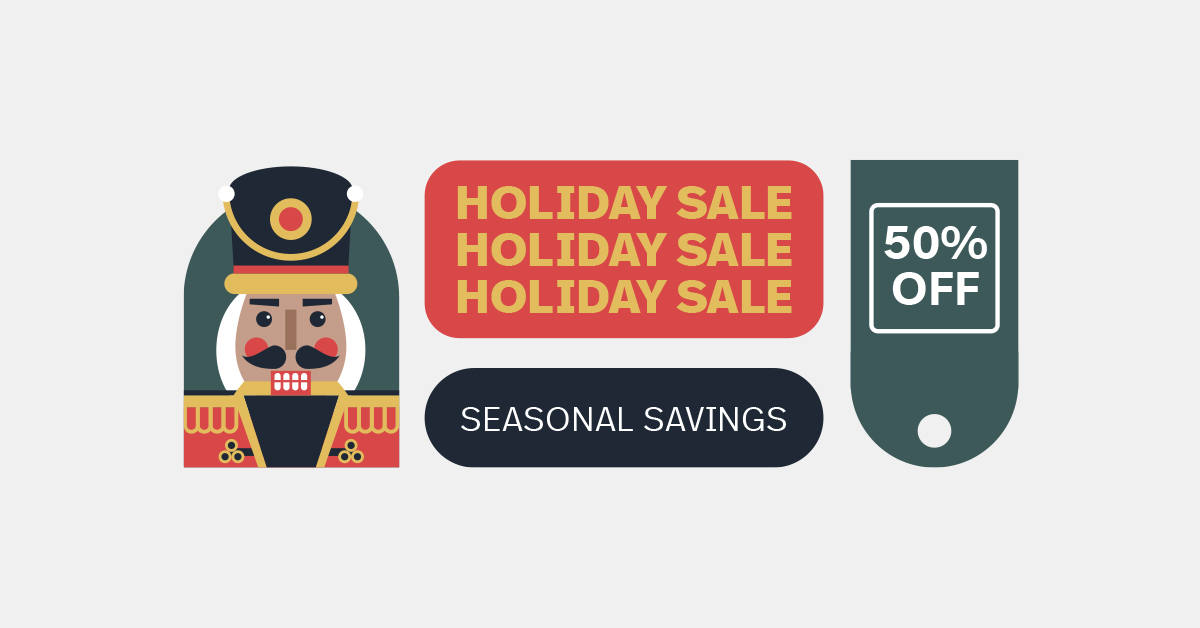
If you’re in the retail or ecommerce industries, it’s never too early to start thinking about your holiday marketing campaign. Why? Because you don’t want to miss out on your slice of the lucrative, gift shopping pie.
According to CNBC, about 40% of a retailer’s annual revenue is generated between Thanksgiving Day and Christmas. Consumers aren’t only shopping in stores. Online holiday shopping is more popular than ever. Experts forecast consumers will spend $910 billion online this holiday season.
With nearly one in two people starting their holiday shopping earlier this year than in previous years, there’s no time like the present to plan your holiday marketing campaigns. Nearly 11% of consumers who plan to shop over Thanksgiving weekend will begin their holiday shopping on Thanksgiving Day. While Black Friday is the most popular shopping day of Thanksgiving weekend, Cyber Monday shopping generates $12 million each minute at peak times.
If you want to cash in on the most important shopping season of the year, you need to start planning your holiday marketing campaigns as soon as possible. Not sure where to get started? Need some holiday marketing campaign ideas? We’ll help by answering your most frequently asked questions about holiday advertising, including:
- What is seasonal advertising?
- What is the best form of marketing for the holidays?
- How do I start a holiday marketing campaign?
- When should I start a holiday marketing campaign?
- What are some examples of successful holiday marketing campaigns?
Retail Report: 50 Easy Holiday Marketing Ideas For Retailers
Your whole year has been leading up to this moment—how are you going to make an impact?

What is seasonal advertising?
Seasonal advertising is marketing focused on holidays, like Christmas, Labor Day, or Mother’s Day. Holidays play an important role in the retail and ecommerce industries because they’re times when consumers spend significantly on gifts, and/or when retailers have special sales to generate revenue.
Christmas and Mother’s Day are examples of holidays in which consumers shop for gifts. Holiday advertising around these occasions, therefore, is focused on generating gift sales.
While Labor Day and President’s Day aren’t associated with gifts, they are associated with major sales, and a good time for consumers to make large purchases. Car dealerships and furniture stores, for example, typically offer promotions and major discounts around these holidays.
Because this article is focused on holiday marketing campaigns, when we mention “holidays” going forward, we’re talking about Christmas, Hanukkah, Kwanzaa and other winter celebrations
What is the best form of marketing for the holidays?
A holistic, omnichannel approach is the best strategy for marketing for the holidays. “Omnichannel” means reaching customers through every medium they engage with, rather than just one.
An omnichannel strategy incorporates digital content marketing channels like email marketing, social media, SMS marketing and influencer marketing. It also includes traditional forms of advertising, such as print (such as a holiday catalog or gift guide), TV and streaming and radio. It’s important to also include experiential marketing, such as holiday pop-ups, creative shopping experiences, in-store events and festive window displays, in your seasonal campaign.
The best holiday marketing campaigns take place across as many platforms as possible. It’s even better if you have an online store in addition to your brick and mortar location. Your marketing can then drive users to the shopping experience that matches their buying preferences.
How do I start a holiday marketing campaign?
Here’s how to get started with – and execute – your seasonal marketing strategy.
1. Establish your goals
First, establish goals for your campaign. Make sure they’re SMART: specific, measurable, attainable, relevant and time bound. Sure, you want to sell as much as possible during the holiday season, but make that goal more specific.
For example, you could use historic sales data from Q4 (check your point-of-sale system’s or ecommerce platform’s reports) to set a revenue benchmark to beat by Christmas Day this year. Another example of a SMART goal is increasing sales of your new footwear collection by 20% over Thanksgiving weekend. Goals like this are specific, measurable, attainable (with the right strategy!), relevant to the season at hand and bound by a deadline.
2. Create a theme
Holiday marketing campaigns work best when they have a memorable theme. Other businesses will be focusing on Christmas trees, snow, and time with loved ones. Create a theme that will stand out. What about an anti-holiday sale? Or a summer themed campaign?
Need holiday marketing campaign ideas? Check out examples of real-world campaigns from major brands below.
3. Pick products to highlight
Next, choose products to include in your holiday marketing campaign. Which items will you feature in your online shop? Which ones will you display in your store’s window? Which products will you put on sale?
Look at historic holiday sales data and current trends to make an educated guess as to this season’s hottest gifts.
4. Create a strategy
Now you can combine your goals, theme and products into a campaign strategy. Like a general marketing plan, your holiday campaign strategy should list the marketing channels you’ll focus on, the types of content you’ll create for each platform, who will be responsible for executing different parts of the campaign and deadlines for each aspect of the campaign.
5. Create content
Next, it’s time for the fun part: making creative content for your campaign. This involves anything from planning photo shoots for your holiday catalog and creating graphics for store signage to writing drafts of email newsletters and social media posts. Create a schedule for producing content and stick to it to make sure you’re ready to roll in time.
6. Execute
Once you have all of the pieces in place for your holiday marketing campaign, you’re ready to press play. Send your newsletters, publish your catalog, schedule your social media posts, invite customers to your holiday shopping event, etc.
7. Measure success
One of the most important parts of your campaign happens when it’s all over: measuring how your results compare to your campaign goals.
It’s also important to calculate the return on your investment into the campaign. How much time and money did you spend creating assets, sending catalogs, and managing social media? What did these efforts result in in terms of sales and audience growth? Use these learnings to help plan next year’s campaign.
When should I start a holiday marketing campaign?
You should start planning your holiday marketing campaign by late summer, so that when fall rolls around, you’re ready to execute. If you think you have to wait until December to launch your seasonal campaign, think again. According to LocaliQ, 56% of consumers finish their holiday shopping before December. Experts say that holiday shopping begins as early as October.
What are some examples of successful holiday marketing campaigns?
If you’re still not sure where to start, use these real-world examples of memorable seasonal campaigns to help you come up with holiday marketing campaign ideas.
Starbucks’ red holiday cup
As the holiday season approaches, Starbucks’ signature green cup turns red to signal that Christmas is near. This holiday marketing campaign has been a tradition for the global coffee giant since 1997.
The reason why this campaign is so successful is that when customers visit Starbucks during the holiday season and walk out with a festive red cup, they become a walking advertisement for the coffee shop. The limited-time vessel signals to other customers that seasonal, limited-time beverages are back on the menu.
Macy’s Believe campaign
When it comes to omnichannel holiday marketing campaigns, nobody does them better than Macy’s. The department store’s annual holiday Believe campaign takes many forms.
First, there’s the experiential marketing aspect, which includes famous window displays at its New York City flagship, a mailbox for letters to Santa at various locations and in-store visits with Santa. There’s also the Macy’s Thanksgiving Day Parade, which ends with a Santa Claus balloon that ushers in the holiday season.
Then there’s the digital aspect of the campaign, which includes a landing page, partnership with the Make-A-Wish Foundation for donations, and matching email marketing and social media promotions.
The result is more than just a holiday marketing campaign: it’s a beloved tradition that shoppers look forward to year after year.
Coca-Cola’s holiday advertising
Coca-Cola is another classic brand known for its memorable holiday campaigns. It all begins with a theme. Each year, the Coca-Cola team chooses a message around which they create a commercial and other campaign collateral.
Many people remember Coca-Cola’s polar bear mascot appearing in many holiday marketing campaigns. Over the last few years, however, the brand has swapped out the polar bear for a new theme every holiday season. In 2020, for example, Coca-Cola launched its “Give Only Something You Can Give” campaign, while in 2021 the campaign was called “Real Magic.”
Wrapping up: Holiday marketing campaign FAQs
The holiday season is the most wonderful time of the year for consumers, as well as the most lucrative time of year for businesses. If you want to cash in on the holidays, you need to create a memorable holiday marketing campaign. Success starts with an omnichannel approach that reaches customers wherever they are: online, in stores, at home, etc. Start planning early—ideally over the summer—to ensure you have plenty of time to roll out your campaign and attract shoppers.
Here’s a summary of the seven steps involved in creating a holiday marketing campaign. Take a screenshot or print it out and reference it as you go:
- Establish your goals
- Create a theme
- Pick products to highlight
- Create a strategy
- Create content
- Execute
- Measure success
Lightspeed POS and eCom can help your business handle the rush your campaigns generate. Watch a demo today to get started.

News you care about. Tips you can use.
Everything your business needs to grow, delivered straight to your inbox.



